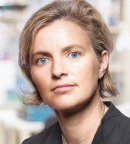Clodagh O’Shea, PhD, Associate Professor in the Salk Institute’s Molecular and Cell Biology Laboratory, is among the first recipients of a grant from the Faculty Scholars Program, a new partnership of Howard Hughes Medical Institute (HHMI), the Bill and Melinda Gates Foundation, and the Simons Foundation for early-career researchers whose work shows the potential for groundbreaking contributions in their fields. Dr. O’Shea is among 84 Faculty Scholars who will receive $100,000 to $400,000 per year over 5 years to support their pursuit of innovative research.
Novel Research on Synthetic Viruses
Dr. O’Shea is at the forefront of cutting-edge technologies to design synthetic viruses and other genetic devices that are controlled and able to selectively target cancer cells. Each time a virus infects a cancer cell and multiplies, the virus kills the cell by bursting it open to release thousands of viral progenies, which go on to target other cancer cells. Synthetic viruses designed to lock onto and rupture cancer cells, while leaving normal cells intact, could result in a novel cancer therapy with virtually no side effects.

Clodagh O’Shea, PhD
To successfully redesign and program synthetic viral therapies, Dr. O’Shea has developed new technologies that enable viral gene delivery devices, cancer therapies, and vaccines to be assembled using libraries of modular DNA parts. Dr. O’Shea proposes to further develop these genetic machines as diagnostic “drones” that identify the earliest traces of cancer; synthetic viruses that destroy tumor cells while preventing therapeutic resistance; and viruses that hone in on damaged tissues to promote wound healing and stave off infection.
“I am very honored to receive an HHMI faculty scholar award, which we will use to identify critical 3D genomic interactions that are subverted in both viral infection and cancer and the rational design of powerful synthetic viral therapies for patients suffering from cancer,” said Dr, O’Shea, who is the holder of the William Scandling Developmental Chair.
Another aspect of O’Shea’s research is to unravel the structural code that determines the functions of DNA in the cell nucleus and whether it can be accessed and used. A cell’s genomic material is not a simple helix: DNA is coiled around proteins to form complex 3D packages called chromatin to fit into the small space of a cell nucleus. Charting and determining the structure of chromatin at multiple scales are vital steps in understanding how viruses access genetic material to replicate and kill cells. To this end, her lab is developing new techniques to visualize how genomic material is structured in time and space. These studies have the potential to reveal the structural code that determines whether a gene is “on” or “off” in health and disease.
The program’s support enables Dr. O’Shea to further refine her genetic machines and designs to be able to, for example, keep up with a tumor’s heterogeneity, engage a protective immune response, and target specific mutations related to difficult-to-treat cancers (eg, those with p53 mutations). ■

